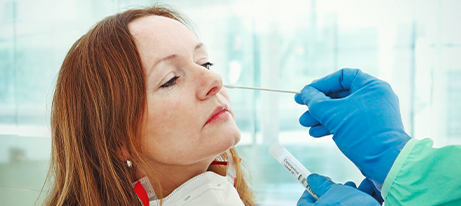
narvikk / Getty Images
The SARS-CoV-2 pandemic in America has led to testing shortages, overburdened commercial labs, and slow turnaround times on results. To remedy the supply issue, federal entities, states, and manufacturers have been strategizing on rapid point-of-care (POC) antigen tests, assays that deliver quicker but perhaps less accurate results than traditional reverse transcription-polymerase-chain reaction (RT-PCR) assays.
PCR testing remains the gold standard for COVID-19. While highly accurate, most tests that use this method also are lab-based and time- and labor-intensive. Shortages of PCR tests and testing supplies along with high demand for testing have led to sustained delays in test turnaround and results reporting, a situation Anthony Fauci, MD, director of the National Institute of Allergy and Infectious Diseases, has described as simply unacceptable.
Testing remains a challenge, acknowledged U.S. Food and Drug Administration (FDA) Commissioner Stephen M. Hahn, MD, in a videoconference with the American Medical Association. “I can only imagine the frustration of having to wait four to six days for a test to come back. I think we are making some progress there, but there are issues out there, particularly with some of the commercial labs,” he said. FDA has been looking to authorize more rapid diagnostic antigen tests to complement PCR. To date, the agency has issued emergency use authorizations for four SARS-CoV-2 antigen diagnostics, the two latest of which are LumiraDX UK’s LumiraDx SARS-CoV-2 Ag Test and Abbott Diagnostics’s BinaxNOW COVID-19 Ag Card.
Interim guidance from the U.S. Centers for Disease Control and Prevention (CDC) seeks to educate labs and clinicians on effective uses for antigen tests. Specimen integrity directly impacts test performance, stressed the agency, which is why proper handling and collection of specimens is critical. Timing is also important: Research indicates that antigen levels may drop below the test’s limit of detection 5 days after a patient becomes symptomatic.
Antigen tests have performance limitations, as Ohio Gov. Mike DeWine recently discovered. Scheduled for a meeting with President Donald Trump in Cleveland, DeWine had to change his plans after a rapid POC antigen test came back positive. Retested hours later with a PCR test, DeWine tested negative—several times. While this incident may give some people pause in advocating for rapid tests, some scientists argue that the circumstances of the pandemic call for the availability of more tests, even if they might not be as accurate as PCR methods. “Even if you miss somebody on Day 1,” one clinical microbiology expert told The New York Times, “if you test them repeatedly, the argument is, you’ll catch them the next time around.”
States are trying to increase coronavirus testing with faster methods, undeterred by less accurate but quicker readouts. Ohio’s DeWine recently joined the governors of Maryland, Louisiana, Massachusetts, Michigan, and Virginia and the Rockefeller Foundation on a bipartisan interstate compact to offer 3 million antigen tests capable of delivering results in 15 to 20 minutes. The hope is deploying these tests will help the states quickly identify and contain outbreaks. The group is in talks with Becton Dickinson (BD) and Quidel, developers of the other two antigen tests authorized for emergency use, to buy 500,000 tests for each state.
“With severe shortages and delays in testing and the federal administration attempting to cut funding for testing, the states are banding together to acquire millions of faster tests to help save lives and slow the spread of COVID-19,” said Maryland Gov. Larry Hogan in a statement. Hogan, who recently left his post as chair of the National Governors Association, expects that other states, cities, and local governments will join the compact.
According to CDC, the BD and Quidel tests demonstrate a sensitivity of 84% and 97% compared to RT-PCR. But rapid antigen tests don’t always perform well in clinical trials. In one study, a test identified RT-PCR-positive samples at ranges between 11.1% and 45.7%. Accuracy may also depend on the brand of test. One novel rapid test from China yielded 93.9% sensitivity and 100% specificity and had a diagnostic accuracy of 96.1% in respiratory samples. In other studies, low sensitivity ruled out certain assays as frontline diagnostic tests.
While their accuracy might be less than ideal, counting antigen tests—both confirmed and probable—in daily tallies could enhance accountability. The Council of State and Territorial Epidemiologists (CSTE) in updated guidance is suggesting that states count antigen tests on a daily basis and report the results to CDC. “States that don’t choose to do that I think are going to put themselves in a lot of risk for not being transparent. And I think it will cause more confusion,” Jeffrey Engel, MD, CSTE’s senior advisor on COVID response, said in a news report.